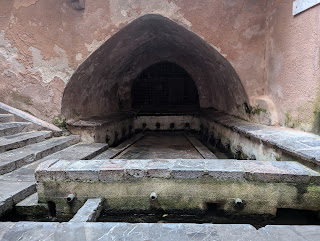
After exploring some of the inland mountain-top towns earlier in the day, Steven and I headed back to the coast toward Cefalu, located about 40 km north of Caccamo. Described as the jewel of the Tyrrhenian Coast, Cefalu was an old Sicilian town that was built on a spur jutting out into the sea. The city was dominated by an immense headland - la rocca - and a 12th-century Romanesque Duomo we looked forward to viewing.
Cefalu was the first town we visited in Sicily, where we had to park outside the city center and the ZTL to avoid getting a traffic ticket.
A common sight throughout Sicily was the small neighborhood fruit and vegetable stands, sometimes simply an open-sided truck that could move from neighborhood to neighborhood.
I never tired of eying pretty ceramic planters on terraced streets throughout Sicily.
We walked along Cefalu's cobblestoned Corso Ruggiero, the main pedestrian street in the old town.
Tucked away in a small square with double stairs leading up to the door was the ornate Baroque facade of the Chiesa Santo Stefano Protomartire o del Purgatorio, built between the 15th and 16th centuries.
We listened as the faithful recited prayers in unison.
The Duomo or Cathedral, a fortress-like structure with impressive Byzantine mosaics and twin towers, is regarded as one of Sicily's most important Arab-Norman buildings, together with Monreale's Cathedral and Palermo's Palatine Chapel, both of which we’d toured a few days previously.
The cathedral was erected at the whim of the Norman King Roger II in 1131 after a vow he made for having survived a shipwreck. He pledged, "If I will save myself from the waves, I will order the construction of a temple to honor you, the Holy Savior and the Apostles, and with the Pope's permission, I will settle (build) an Episcopal Cathedral."
The imposing mosaic figure of the Pantocrator Christ, completed in 1148, graced the central apse. Master and creator, he proclaims himself as the light of the universe from the Gospel he carries. The Latin words say, "I am the light of the world. Those who follow me will not wander in the darkness but will have the light of life."
The glorious mosaics were assigned to Byzantine architects and workers, whose Eastern style was highly influenced by the Nordic and Norman architectural styles.
Steven patiently waited while I beetled into the nearby Museo Mandralisco, a private art collection of Baron Pirajmo di Mandralisco, a member of a local aristocratic family. The antiques, artwork, fossils, and ancient ceramics he amassed throughout his life now form the museum's extensive collection.
His library contained texts from the second half of the 15th century.
I just had to stop and admire this 24-drawer stunning chest. It was made in 1630 of ebony and mother-of-pearl panels with turned ivory insets. Some of its drawers were hidden, while others had curious hiding places inside.
The museum's most significant piece of work (and the sole reason I wanted to stop in) was the Portrait of Unknown Man by Antonello di Messina. The mysterious working man is considered one of the early Renaissance artist's masterpieces. I could certainly understand why it had been dubbed the Sicilian Mona Lisa!
An unknown Cretan-Venetian painter created Madonna col Bambino with tempera in the 16th century:
Other remarkable pieces were this vessel from 480 BC and ...the 4th-century BC Tragic Mask, and ...
the Head of Heracles, created in the second half of the 1st century BC.
The Lavatorio Medievale, or the medieval washhouse, located at sea level, about four meters below street level, was used until the early 20th century to wash clothes. The washhouse's many basins were replenished by the waters flowing from the Cefalino River, which flowed out from 22 iron, lion-shaped mouths. It was accessible through a wide, curved limestone staircase.

What a fascinating way to get a sense of what life was like in the Middle Ages in Sicily.
The Chiesa di Maria Santissima della Catena was a significant landmark in Cefalu. Completed in 1780, the church's baroque facade was adorned with golden stone and statues in niches.
For the second night in a row, we had a hair-raising experience finding our rental property, as it was also located high in the hills overlooking the city. We'd again crammed too much in the day, which resulted in our leaving Cefalu later than we had planned, so it was completely dark. Note to self: plan the days better going forward!
Next post: Castel di Tusa's spread out Fiumara d'Arte Sculpture Park.
Posted on November 22nd, 2024, from Ottawa, Canada, where I've been visiting my four brothers and catching up with dear friends I've known for decades. After a couple of days of seeing another childhood friend in Toronto, I'm going home to Steven in Denver. Take care of yourself and be there for your loved ones while you can.


































The Portrait of Unknown Man by Antonello di Messina really does emulate a mysterious smile on canvass (as does the infamous Mona Lisa) . xo Lina xo
ReplyDeleteLina, you pegged that amazing portrait perfectly as the similarities are striking.
ReplyDeleteWonderful seeing you I Ottawa! Love and hugs.
Thanks for the card! Graterful for your friendships!
ReplyDeleteNot sure whom this is from but you're welcome and I'm also glad of your friendship!
ReplyDelete